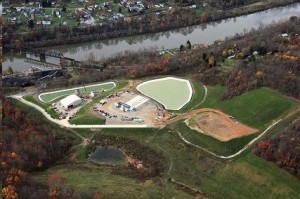A crystalline waterproofing technology helps the brand new AOP Clearwater facility clean up wastewater used for the extraction of natural gas.
From Penetron, PR News, March 24, 2014
Located in Fairmont, West Virginia, the AOP Clearwater recently began operation as a “one of a kind” facility to treat and recycle water. This water is used in the “fracking” of natural gas extracted from the Marcellus shale formation.
The Marcellus shale formation is a layer of sedimentary rock deposited over 350 million years ago in the Appalachian regions of western New York, Pennsylvania, Ohio, and West Virginia. This formation contains significant quantities of natural gas; current estimates predict the over one-mile-deep formations may contain up to 363 trillion cubic feet of natural gas. This is enough to supply the needs of the entire United States for nearly 15 years.
Problematic Extraction Process
Extracting natural gas from the carbon rich deposits demands drilling and fracking techniques that inject significant volumes of water (an estimated three million gallons per well head), pressurized to open up the pores in the rock and allow the gas to be collected. This water becomes contaminated with high concentrations of brines, heavy metals, and organics and must be completely removed from the well before gas production can begin.
The high concentrations of contaminants and salt brine (up to 25 %) in the returned water make it necessary to treat the large volumes of water in sophisticated treatment systems. The AOP Clearwater facility applies several treatment layers that include settling basins, bag filters and carbon filters to remove the heavy metals and contaminants. The final treatment uses multi-phase evaporators to remove the sodium chloride or salt from the brine-laden fracking water.
Greatly Enhanced Durability
Penetron Admix was selected for all the concrete structures, including the settling basins and the delivery/receiving stations, to minimize chemical penetration into the concrete. The salt brine, with up to 25% concentrations of sodium chloride, could rapidly damage the reinforcing members of the concrete and quickly deteriorate the structures.
“As shown in independent tests, Penetron Admix can reduce chloride penetration in concrete by 89%,” adds Christopher Chen, Director of The Penetron Group, “virtually eliminating any chloride penetration to a depth beyond one inch and significantly increasing the durability of AOP Clearwater’s concrete structures.”
Running now at full capacity, the AOP Clearwater facility has a treatment capacity of 210,000 gallons per day. Over 80% of the cleaned water is recycled back to the drillers to be used again, making a substantial contribution toward cleaning up today’s fracking process and enabling the long sought dream of energy independence for the country.


{ 1 comment… read it below or add one }
I have some serious thoughts about this article. It is obviously meant to sell more of the Pemetron product. That’s OK. But it is not a good source of information for and about the work the plant is doing.
First, the waterproofing of the plant is peripheral to the quality of work that is being done there. It will make the plant last longer, but contamination by leakage through the cement would be small compared to what goes out with the end products. Obviously they take out particulates with settling basins, bag filters and carbon filters, and the latter takes out some readily adsorbable stuff. It would be interesting to know the way settlings and bags are handled.
Contrary to the way the author expresses it, they don’t take the salt out of the brine, they take the water out of the brine, leaving more concentrated brine, paste or dry mixture. Separation by evaporation requires about 15,000 cubic feet of gas per day at 210,000 gallons processed per day. Or they use reverse osmosis. The big question is what happens to the volatiles – up the stack and out into the neighborhood? Which is SOP for the fracking industry.
What about the stuff that is left after the reusable water is removed? Salt is not just NaCl, but a major class of chemicals, some of them pretty bad. There are a lot of different salts and many other kinds of chemicals in frackwater. Do they go to a landfill? or an injection well? The reject product is obviously a hazard to ground water.
It is one of a kind? Who designed it, and what engineering competence was involved? Anybody with an appropriate education involved in design or operation? One of a kind? What regulations are involved? What safety checks? What government regulation does it fall under?
Or is it “trust me, just trust me” to the public?